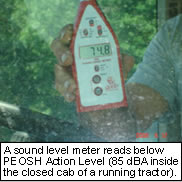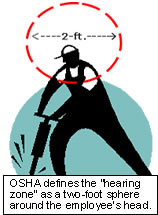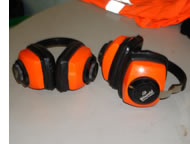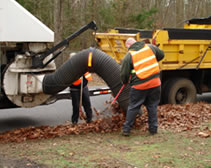- Home
- Public Employees Occupational Safety and Health
- PEOSH Health Standards
- PEOSH Occupational Noise Standard (29 CFR 1910.95)
PEOSH Occupational Noise Standard (29 CFR 1910.95)
Noise is unwanted sound and is an extensive occupational health problem. More than 30 million Americans are exposed to hazardous sound levels on a regular basis. Unlike many occupational hazards, exposures to harmful sound levels can also occur in recreational settings, homes, almost anywhere. Thus, the effects of a work exposure may be aggravated by other activities. To protect hearing, people should take measures to limit or minimize all exposures to harmful sound levels. This can be done by either controlling the sound source by reducing the level, by isolating the source or muffling the sound or by the use of personal protective equipment such as ear plugs or muffs. Hearing loss occurs in two basic ways: conductive and sensorineural. Conductive hearing loss is caused by a problem with a part of the outer or middle ear. A breakdown or obstruction interferes with sound transmission. This type of hearing loss is common and can often be reversed and hearing restored with appropriate treatment. Sensorineural hearing loss occurs from changes in the receptor hair cells in the inner ear or in the nerves carrying impulses to the brain. This type of hearing loss is usually permanent. Noise-induced hearing loss (NIHL) is sensorineural and is usually permanent. Fortunately, workplace NIHL can be reduced or even eliminated by the successful application of an occupational hearing loss prevention program.
The PEOSH Occupational Noise Exposure Standard has been adopted, by reference, from the U.S. Department of Labor Occupational Noise Exposure Standard (29 CFR 1910.95)
- Occupational noise exposure
- Occupational hearing conservation
- program
- Noise exposure monitoring
- Administrative and engineering controls
- Audiometric evaluation
- Yearly audiograms
- Hearing protection
- Noise reduction rating
Occupational Noise Exposure
The Occupational Noise Exposure Standard requires that protection against the effects of noise exposure be provided when sound levels exceed those shown in the following table when measured on the “A” scale of a standard sound level meter at slow response. Table 1 is the list of permissible noise exposures from the noise standard.
| TABLE 1 - Permissible Noise Exposures | |
| Exposure Duration (hours) |
Decibels (dBA) |
| 8 | 90 |
| 6 | 92 |
| 4 | 95 |
| 3 | 97 |
| 2 | 100 |
| 1.5 | 102 |
| 1 | 105 |
| 0.5 | 110 |
| 0.25 | 115 |
The standard requires that feasible administrative or engineering controls be utilized when levels exceed those listed. If these controls fail to reduce the sound level to those listed, personal protective equipment must be provided and used to reduce sound levels to within the levels of the table. If employee noise exposures equal or exceed an 8-hour time-weighted average (TWA) of 85 dB measured on the “A” scale (slow response) or the equivalent 50 percent dose, the employer must administer a continuing, effective hearing conservation program as described in 29 CFR 1910.95 Standard.
 Occupational Hearing Conservation Program
Occupational Hearing Conservation Program
An occupational hearing conservation program has seven basic components:
- Noise exposure monitoring
- Administrative and engineering controls
- Audiometric evaluation
- Use of hearing protection devices (ear plugs and muffs)
- Education and motivation
- Recordkeeping, and
- Program evaluation.
Noise Exposure Monitoring
The PEOSH Occupational Noise Exposure Standard, 29 CFR1910.95, states that “When information indicates that any employee’s exposure may equal or exceed an 8-hour time-weighted average of 85 decibels (dB) the employer shall develop and implement a monitoring program (29 CFR 1910.95(d)). The three most common methods of noise monitoring are area surveys, personal dosimetry and engineering surveys. In an area survey, a sound level meter is used to measure environmental noise levels. This information may be used to identify areas where more thorough noise exposure evaluation is needed. Personal dosimetry, a method of evaluating an employee’s individual exposure, is used to determine the noise levels experienced by employees throughout the work shift. A noise measuring instrument with the microphone positioned in the employee’s hearing zone is used to measure sound levels. OSHA defines the “hearing zone” as a two-foot sphere around the employee’s head. This type of monitoring result can also represent the exposure of other workers whose exposures result from the same tasks. During engineering surveys, octave band analyzers and sound level recorders are used to obtain information on the frequency/intensity composition of noise. This information can be used in assessing options for applying engineering controls.
 Administrative and Engineering Controls
Administrative and Engineering Controls
Administrative and engineering controls can be used to reduce exposures to the point where the hazard is eliminated or reduced to manageable proportions. These control measures consist of removing the worker or removing the hazard. This may be accomplished by substituting less noisy equipment for instance. Administrative controls include work scheduling and task assignment. Individual employee exposure is reduced by decreasing the amount of time spent in a noisy environment. Engineering controls include mufflers, sound barriers, enclosures, and sound absorbing materials. These either decrease levels through sound absorption or redirect the sound to unoccupied areas.
Audiometric Evaluation
Audiometric evaluation is required if employees are exposed to sound levels equal to or exceeding an 8 hour TWA of 85 dB. This evaluation consists of a baseline audiogram obtained within 6 months of an employee’s first exposure to levels of 85dB or greater followed by yearly retesting. The baseline audiogram must be preceded by 14 hours without exposure to workplace noise. The baseline audiogram is then compared to the most recent test to determine if the audiogram is valid and if a standard threshold shift (STS) has occurred in the employee’s hearing. A STS is defined as an average shift from baseline of 10 dB or more in the audiometric frequencies 2000, 3000, and 4000 Hz. In determining whether a STS has occurred an adjustment allowing for the contribution of aging (presbycusis) to hearing loss may be made. The procedure for this adjustment is described in Appendix F of the standard (Calculation and Application of Age Correction to Audiograms). A STS is a sign that the employee has begun to lose hearing and that intervention is needed to prevent further hearing loss. If an STS has occurred, the employer must notify the affected employee in writing within 21 days. Unless a physician determines that the shift is NOT work-related, the standard requires that the employer shall ensure that:
- employees not wearing hearing protection are fitted and trained in their use and care and required to use them;
- employees already using hearing protection shall be re-fitted and re-trained;
- employees are provided with hearing protection providing greater attenuation if necessary;
- employees are referred for further appropriate testing.
Yearly Audiograms
A yearly audiogram serves two main purposes: 1) individual employees who may have experienced an adverse reaction to occupational noise can be identified and follow up procedures to protect the employee can be instituted; and, 2) the effectiveness of the hearing conservation programs can be measured.
 Hearing Protection
Hearing Protection
Personal protective equipment for hearing protection is of two basic types, ear plugs and muffs, and a variety of each type is available. The choice of hearing protection provided should be based on the sound levels present in the workplace where the hearing protection will be used. This level along with information about the noise reduction rating of the hearing protection can be used to select adequate protection.
Noise Reduction Rating
The Noise Reduction Rating (NRR) is a single-number rating method that describes the protection provided by a hearing protector. It indicates how much the overall noise level is reduced by the hearing protector. Field studies by the National Institute for Occupational Safety and Health (NIOSH) have shown that employees normally achieve only about 1/2 of the noise reduction provided by hearing protection. To correctly estimate the noise reduction provided by hearing protection devices, it is important to remember to first subtract 7 from the NRR and then subtract the remainder from the A weighted noise level. Appendix B of the standard (Methods for Estimating the Adequacy of Hearing Protector Attenuation) requires this adjustment when assessing the adequacy of hearing protection devices.
- OSHA Hearing Conservation Topic Page - provides additional information on regulatory compliance
- NIOSH Hearing Loss Prevention Topic Page - provides information on the latest research related to occupational noise exposure.


